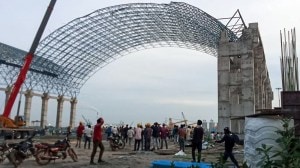Russian satellite with ‘mysterious origin’ breaks up in orbit, leaves behind clouds of space junk
A Russian satellite with "mysterious origins" broke up in the atmosphere at an altitude of about 1,169 kilometres, leaving behind a cloud of space junk that could last in orbit for more than a century.
 The Kosmos 2499 satellite was reportedly clandestinely launched by Roscosmos in 2014. (Illustrative image) (Image credit: ESA)
The Kosmos 2499 satellite was reportedly clandestinely launched by Roscosmos in 2014. (Illustrative image) (Image credit: ESA) A Russian satellite called Kosmos 2499 broke up in Earth’s orbit at an altitude of 1,169 kilometres on January 4, leaving behind at least 85 different pieces of space junk, according to the US Space Force.
The Kosmos 2499 satellite’s break up happened on Saturday morning, according to the US Space Force’s 18th Space Defense Squadron, which tracks all man-made objects in Earth’s orbit. The cloud of space debris caused by the break up could last in the atmosphere for well over a century since, according to NASA, orbital debris more than 1,000 kilometres above the Earth will continue circling the planet for hundred years or more before they fall back to Earth.
#18SDS has confirmed the breakup of COSMOS 2499 (#39765, 2014-028E) – occurred Jan 4, 2023 at appx 0357 UTC. Tracking 85 associated pieces at est 1169 km altitude – analysis ongoing. #spacedebris #space @SpaceTrackOrg @US_SpaceCom @ussfspoc
— 18th Space Defense Squadron (@18thSDS) February 7, 2023
Interestingly, this may not be the first time that the satellite broke up in orbit. According to Harvard & Smithsonian Centre for Astrophysics (CfA) astronomer Jonathan McDowell, this is the second breakup of the satellite after the first one on October 23, 2021. McDowell on Twitter said that he suspected the new event is the further break up of already broken-down parts.
This is the second breakup of Kosmos-2499, after the first one on 2021 Oct 23. https://t.co/ABfcWDjgFF
— Jonathan McDowell (@planet4589) February 7, 2023
But that is just the tip of the iceberg when it comes to the mysteries associated with the satellite, according to Space.com. Kosmos 2499 was launched by a Russian Rocket vehicle in 2014 along with three Rodik military communications satellites. But interestingly, the satellite was not officially in the launch manifest, according to RussianSpaceWeb.com.
Once in orbit, this “ghost” satellite made some orbital manoeuvres that led to suspicions that it was a platform to test technology that would allow spacecraft to attack and disable satellites. In fact, this prompted erstwhile Roscosmos (Russian space agency) head Oleg Ostapenko to announce that the Kosmos 2499 and a similar Kosmos 2491 satellite are not “killer satellites,” according to RussianSpaceWeb.com.







